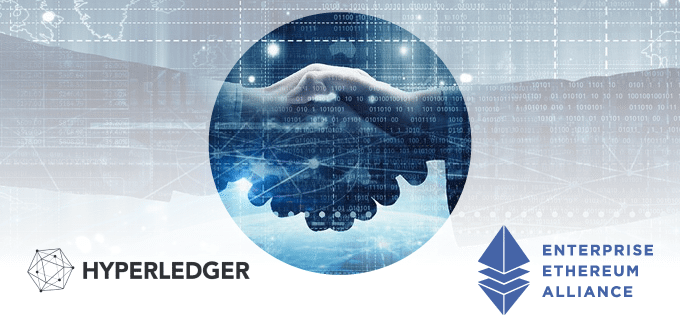
Hyperledger and the Enterprise Ethereum Alliance (EEA), two of the world’s largest blockchain consortia, have announced a cross-community collaboration to accelerate the adoption of blockchain technology for business. The two have formally become associate members within each other’s organization, Hyperledger and the EEA announced on Monday.
“This is a time of great opportunity,” said Ron Resnick, the EEA’s executive director. “Collaborating through mutual associate membership provides more opportunities for both organizations to work more closely together.”
The cross-community collaboration means that the leadership of both organizations will be able to collaborate across Special Internet Groups, Working Groups, meetups and conferences globally.
The EEA sponsors the development of specifications and standards for enterprise blockchain networks with a focus on those aligned with the broader Ethereum ecosystem. Hyperledger, a Linux Foundation open source collaborative effort, fosters the development of open source software for establishing, managing and connecting enterprise blockchain networks.
The new partnership seeks to encourage Ethereum developers to submit their enterprise projects to Hyperledger, and Hyperledger project maintainers to take de-facto interfaces appropriate for standardization to the appropriate EEA working groups.
Brian Behlendorf, executive director of Hyperledger, said the collaboration was “a nature alliance for both organizations.”
“Great open standards depend upon great open source code. Standards, specifications and certification all help enterprise blockchain customers commit to implementations with confidence since they have better assurances of interoperability as well as multiple vendors of choice.”
Industry participants welcomed the move which, according to Nick Cowan, CEO at Gibraltar Blockchain Exchange (GBX), represents “a significant milestone for the wider blockchain ecosystem.”
“The real winners are the prospective blockchain projects that previously would have had interoperability concerns when deciding to pursue blockchain innovation using Ethereum or Hyperledger,” Cowan said.
“This joint effort between two of the largest enterprise blockchain communities is indicative of the collaborative spirit that will accelerate the adoption of blockchain into the mainstream.”
Gabriele Giancola, CEO and co-founder of qiibee, the Swiss loyalty token protocol helping brands run their loyalty programs on the blockchain, noted the growing number of developers asking for some level of standardization, and thus interoperability.
“This becomes even more relevant as blockchain technology continues to attract wide interest and expands into new industries, which reiterates the need for a regulatory framework. If blockchain is to reach mainstream adoption, there will need to be regulatory standards put into place, but I believe this will benefit the ecosystem as a whole.”
One of the organizations’ works underway is the Hyperledger Burrow project, an Apache-licensed implementation of the Ethereum Virtual Machine (EVM) bytecode interpreter. Earlier this year, Hyperledger Sawtooth, a codebase contributed by Intel, added support for the EVM as a transaction processor, bringing smart contracts developed for the Ethereum mainnet over to Sawtooth-based networks. The effort, dubbed Seth, is now in active use and the developers “anticipate submitting it for conformance testing to the EEA specification as soon as possible.”
Other example of collaboration is the EEA’s Special Interest Group on Trusted Execution Environments, and the prototype implementation of those proposed standards, called Private Data Objects being built as a lab at Hyperledger.

